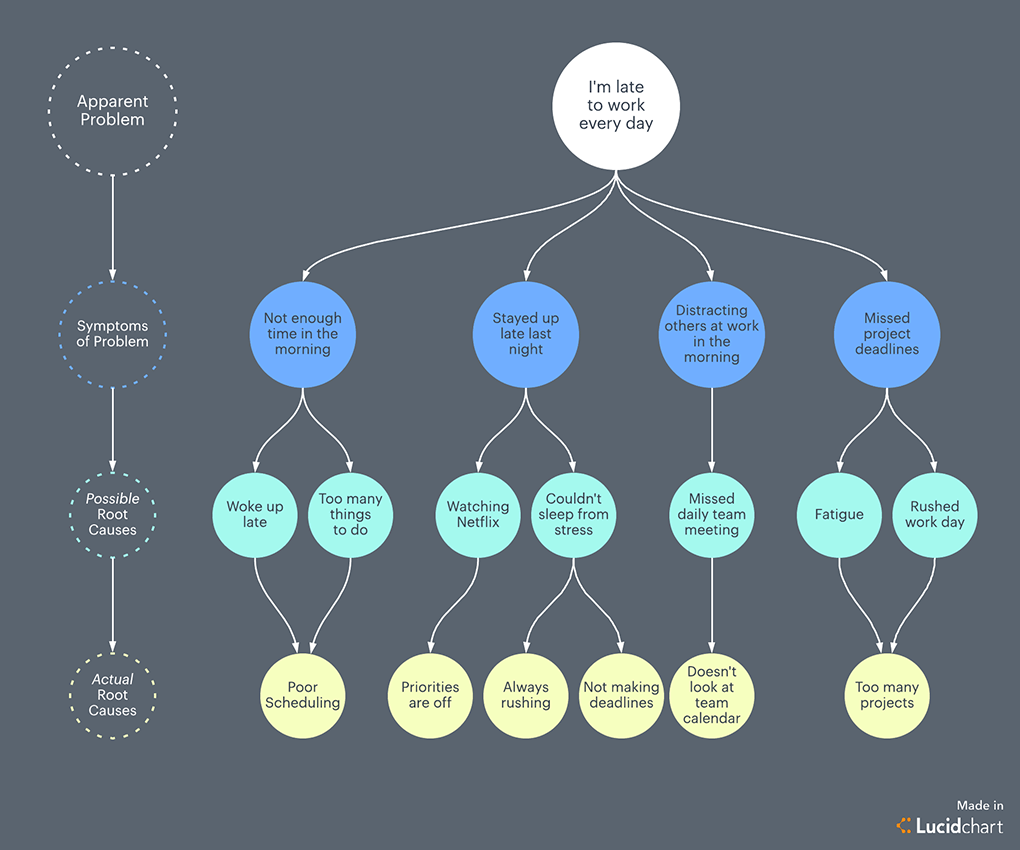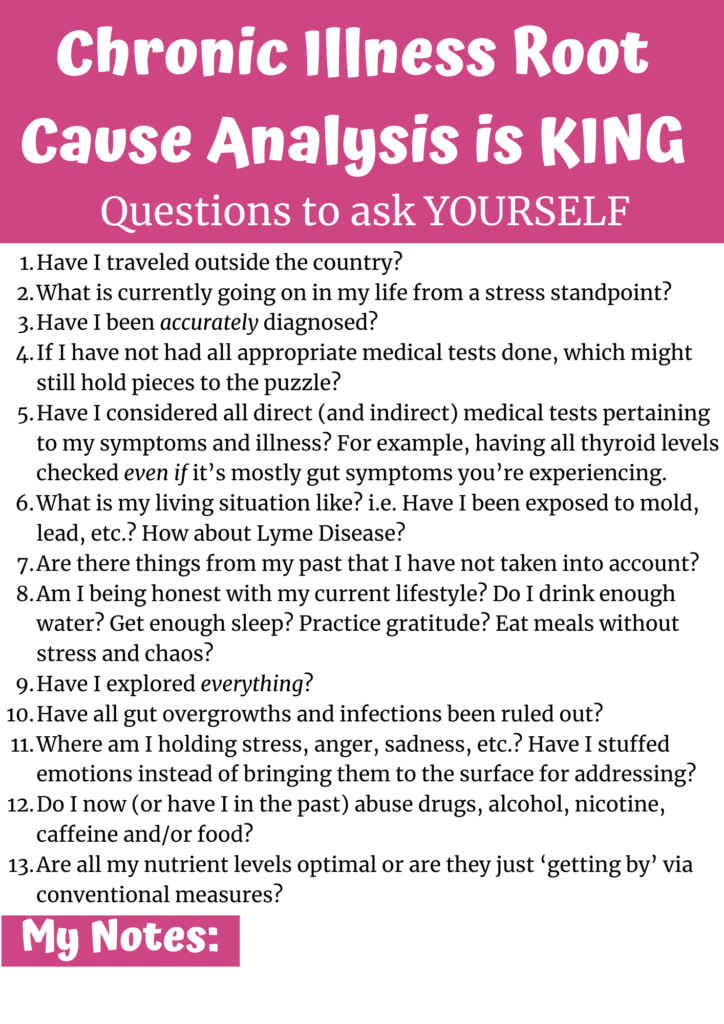Digging deep into your own chronic illness root cause analysis is king.
Without understanding the underlying cause for irritable bowel syndrome, inflammatory bowel disease, and/or any other chronic illness you are dealing with, you’ll likely never heal.
I’ve been asking people for their questions around SIBO and what’s still confusing.
Asked in many different ways, here is a common question and theme:
What to eat when everything, even healthy things, hurt your stomach?
So I got to thinking about this.
And it reminded me of this topic around root cause analysis.
Conducting a root cause analysis might be the next critical step on your journey.

What is Root Cause Analysis
There are many different ideas and definitions for what root cause analysis is. Depending on how the analysis is being applied, the definition might change some.
Because of this, I want to share with you the very broad definition,
In science and engineering, root cause analysis (RCA) is a method of problem solving used for identifying the root causes of faults or problems. It is widely used in IT operations, telecommunications, industrial process control, accident analysis (e.g., in aviation, rail transport, or nuclear plants), medicine (for medical diagnosis), healthcare industry (e.g., for epidemiology), etc.
And depending on the type of root cause analysis you’re doing, the graphical ‘template’ changes.
For the purposes of this post, here is one I love to help explain what we’re doing and how we can apply it to chronic illness.

To arrive at some conclusions, there are steps to follow.
These are the 5 simplest steps to begin with.
- Define the problem.
- Gather all information and data.
- Identify the issues that contributed to the problem.
- Arrive at a conclusion.
- Recommend solutions for implementation.
Root Cause Analysis: 5 Whys
And within those 5 steps, it’s helpful to invest some time with the approach of asking 5 Whys.
It looks like this.

And the reason I appreciate this approach is because I have done something very similar.
Here is an exercise I have done time-and-time again on my healing journey:
….but why?
In other words, whenever something I’m doing isn’t adding up (prohibiting my healing), I simply state the action and then ask myself, “….but why?”
You can apply it for anything you have become habitual about, but the place where I realized it had the most impact on my life was when I asked it around my workouts.
- “I have to run 7 miles today.” —> ….but why?
- “I will do another half-marathon.” —> ….but why?
- “I’m going to get stronger and fitter.” —> ….but why?
Seriously, it’s how I ended up fully understanding that what I was doing from a physical standpoint was ridiculous (while healing).
And it’s also how I was able to confidently experience, write, and share my viewpoints on gut healing and working out.
Anyways, let’s dig even more into this all with some examples.
Chronic Illness Root Cause Analysis is King
Click HERE to save this post for later.

1. Define the problem
What is the problem and what are the symptoms of that problem?
2. Gather all information and data
Ask yourself things like:
- How long have these issues been going on?
- What are the signs of proof of these problems or issues?
- Are the impacts measurable, i.e. loss of time, productivity, quality of life, etc.?
3. Identify the issues that contributed to the problem
This is where you can also do the ‘5 Whys’ exercise.
Was there a series or sequence of events that led to the problem or allowed the problem to occur?
Are there additional problems that stem from this?
4. Arrive at a conclusion
Why is this problem occurring?
5. Recommend solutions for implementation
What solutions are necessary?
Who will be responsible for the solution and its implementation?
Are there any risks associated with implementing the chosen solution?
Example: I can’t eat anything.
Let’s do an actual example, based off the initial question,
What to eat when everything, even healthy things, hurt your stomach?
And by the way, this is the simplest example possible. I’m just using it for demonstration.
The analysis you conduct should be far more robust.
Define the problem
- I can’t eat anything.
Gather all information and data
- This has been going on for 3 months.
- When I eat an apple, my stomach hurts. When I eat beef, my stomach hurts. And when I eat candy, my stomach hurts. It doesn’t matter what I eat.
- My stomach constantly hurts.
- I’m bloated and miserable.
- I miss a lot of work because my stomach cramps and I’m in pain.
Identify the issues that contributed to the problem
Here is where you could do the ‘5 Why’s’ exercise.
- I can’t eat anything.
- Why?
- Because I don’t know what food(s) are affecting me negatively.
- Why?
- I’m not sure what I’m eating, what quantities I’m eating, how I’m eating those foods, when I’m eating those foods, etc.
- Why?
- Because I don’t what to keep a food journal.
- Why?
- Food journaling is too much work.
- Why?
- I can’t eat anything.
Arrive at a conclusion
- Perhaps it’s not that I can’t eat anything, but instead that I don’t really know what I’m eating, when I’m eating it, and what circumstances I’m eating it under.
Solutions
- Keep a strict food journal for 30 days, ensuring I’m tracking ingredients correctly, and then re-evaluate.
Sources: HERE, HERE, HERE, and HERE.
Is Root Cause Analysis Really This Easy?
Now, you maybe just read the above example scenario and thought,
No. It’s not that easy. My situation is far more complicated than not knowing what I’m eating on any given day.
For many of you, I absolutely agree.
In fact, getting to the root cause of chronic illness is hard! This is why it can take so long; if it was that easy for everyone, I would not even need to be writing this post.
Therefore, when going through your own root cause analysis, here are 13 questions to consider:
- Have I traveled outside the country?
- What is currently going on in my life from a stress standpoint?
- Have I been accurately diagnosed?
- If I have not had all appropriate medical tests done, which might still hold pieces to the puzzle?
- Have I considered all direct (and indirect) medical tests pertaining to my symptoms and illness? For example, having all thyroid levels checked even if it’s mostly gut symptoms you’re experiencing.
- What is my living situation like? i.e. Have I been exposed to mold, lead, etc.? How about Lyme Disease?
- Are there things from my past that I have not taken into account?
- Am I being honest with my current lifestyle? Do I drink enough water? Get enough sleep? Practice gratitude? Eat meals without stress and chaos?
- Have I explored everything?
- Have all gut overgrowths and infections been ruled out?
- Where am I holding stress, anger, sadness, etc.? Have I stuffed emotions instead of bringing them to the surface for addressing?
- Do I now (or have I in the past) abuse drugs, alcohol, nicotine, caffeine and/or food?
- Are all my nutrient levels optimal or are they just ‘getting by’ via conventional measures?

Think Outside the Conventional Box
You must think along those more detailed and complex lines in order to truly conduct your own chronic illness root cause analysis. Get outside of the conventional box that has you going from point A to B in no time by taking a medication and watching your dairy intake.
It’s 99.9% of the time never going to be that easy.
Asking and doing are two very different things, though. If you ask yourself the question, and you’re not truly sure about the answer, then stop asking and get to the doing.
For example, because this actually was my scenario (I just never had a post like this to help make me aware of it at the time!):
You’ve been given a Colitis diagnosis. Because that’s severe enough, you think you’re set. No way could you also have a gut overgrowth or infection, right?! Wrong! I did. I was diagnosed with Colitis in 2008, but would not find out about the SIBO until I was rock bottom miserable (in 2014).
And even when I knew the SIBO diagnosis, that was still not the end.
This graphic depicts why.

SIBO might be discovered, but even then, I had to uncover why the overgrowth was present to begin with.
“Just because,” is not the answer.
I did not understand that in 2014, which is why it took 4 years to fully heal from SIBO.
Don’t stay miserable; do the root cause analysis.
Along with the questions from above, there are also more tools you can use for these exercises.
Tools for Chronic Illness Root Cause Analysis
Here are 3 primary tools/resources that will help in conducting this analysis ASAP:
- Journal
Actually and truly – a journal. Almost every single step from above will be expedited with the help from my gut healing journaling system. While the printed version is the prettiest and done-for-you-ready-to-go, you can also grab the PDF version, print yourself, and get started today.
2. When Gut Healing is Expensive
Take my tips and tools from this post to help arrive at the root cause.
3. Three Pillars
Use, study, and apply my 3 pillars to ultimate gut healing. Which of them are you neglecting? Do you think it’s contributing to the problem? Be honest with yourself.
The Reason Why There is No ONE Gut-Healing Diet For Everyone
While this might all seem too complicated, it’s really not.
Honestly, you can simplify the process as much as you want or need.
My real goal and point for writing and sharing this post with you was to prove that this is the reason why there is no one diet that will work for everyone.
Let me break it down a little more for you with an example.
Jill has SIBO so she follows a low-FODMAP diet.
Kelly has SIBO so she follows a low-FODMAP diet.
Kelly is doing great on her low-FODMAP diet, but Jill is not.
Jill, however, does not know that her SIBO was caused by slow motility due to low stomach acid. So when Jill eats white rice, green beans, and a ton of ground beef, her stomach acid levels are not adequate to break down the ground beef. Thus, digestion is not optimal and she feels miserable.
Until Jill gets to that root cause of low stomach acid (and why it’s low to begin with), her low-FODMAP diet will not be “the thing” that helps heal her.
While this root cause example is simple and basic, most women with IBS, IBD and/or any other chronic illness have far more to uncover at the root.
And thus, I go back to the idea that your diet is not the thing that will make or break your healing efforts.
So let’s return to the place we started this conversation.
What to eat when everything, even healthy things, hurt your stomach?
Go through the motions as described above.
It would be very easy for me to tell you, “Maybe you’re eating too many ‘healthy’ things like raw fruits and vegetables. So, try eating more meats, broths, and fats. Consider experimenting with the Keto Diet.”
And, in fact, many people will tell you that, leaving you even more confused and miserable.
So I will not give you a template answer because there isn’t one.
While I believe that healing the gut requires a lot more chilling the frank out, I also believe that it requires a deeper introspective analysis. This analysis needs to be conducted by both oneself and also in conjunction with other practitioners.
Because chronic illness root cause analysis is king.
And you’re the queen, darling.
If you liked this post, you might also enjoy:
Xox,
SKH
🤰 bloating be gone! weight loss through optimal gut health for women
💃ʜᴇᴀʟ ʏᴏᴜʀ ɢᴜᴛ. ʜᴇᴀʟ ʏᴏᴜʀ ʟɪfe.
🫶🏻 founder gutbyome.com






